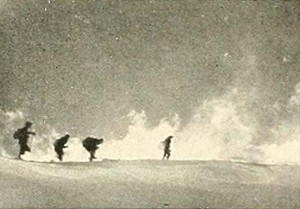
"A down mountain ski run, etched against a filtered sky and set in a world of fantastic snow shapes and incredible beauty, is the theme of Mount Zao, which was filmed on the Japanese mountain of that name. Khoji Tsukamoto has mastered the technique of back lighting the dramatic turns, stems and jumps of a down mountain run so that they are framed against luminous clouds of powdered snow. The ski runners are always preceded by an ubiquitous cameraman who has invariably chosen the most effective angle for each scene of his closely knit sequences. The result is as smooth a picture of skiing as the screen has seen. In sequencing, editing and the nuances of tempo, this film is near the top. And particularly praiseworthy is the way in which the cameraman has involved backgrounds of astonishing natural beauty with foregrounds of interest compelling action." Movie Makers, Dec. 1937, 603, 626.
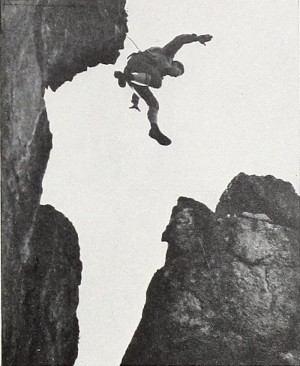
"The Mountaineers Club Teton Expedition, made by Ray Garner, tells the story of several young men who did some real mountain climbing among the peaks of famous Western mountains. A most interesting introduction, showing briefly the various types of climbing, prepared the audience for some of the amazing sequences later on. Remarkable attention to human interest details sustains the entertainment quality throughout and, when the actual climbing starts, the thrills are second to none. The agility of the cameraman contributed greatly to the effectiveness of the film." Movie Makers, Dec, 1936, 550.
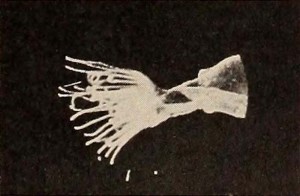
"The eagerness of a movie maker to use a new cine camera is the clever introduction and leitmotivof Movie Bugs, an exceedingly well photographed picture by Dr. Frederick W. Brock. The picture tells how the movie maker protagonist gets in touch with a science teacher and how the two of them construct a support for the camera for use with it in filming through a microscope. The succeeding shots of hydrae and paramecia and other microscopic organisms are beautifully filmed, and the picture infers the obvious conclusion that any university zoology department should be equipped to make such studies. Clean cut interior lighting and a well knit story distinguish this fine filming job." Movie Makers, Dec. 1938, 620.
"Film of members of the Toronto Movie Club filming fruit tree blossoms and scenery at the Woodley family property at West Hill." Library and Archives Canada.
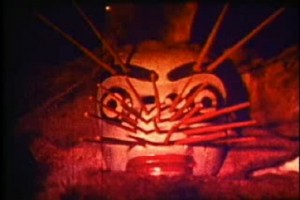
"Mungo Martin demonstrates the making of a Bee Mask. Tony Hunt models the mask and provides a short rendition of the Bee Mask Dance" (Duffy, 140).
This film is also known as Mungo Martin Makes a Mask.
"This film shows Charles Devenish Woodley making a film." Library and Archives Canada.
"My Sierra Hideway: Leon Paddock, using a Bolex H-16 camera and a variety of four lenses, has produced a fine pictorial account of the beauties of the High Sierra mountains in California. The sound, on magnetic tape, enhances the film's presentation which gets off to a fine start with excellent titles." American Cinematographer, May. 1951, 192.
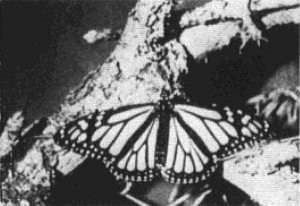
"The monarch butterfly comes home to the butterfly trees at Pacific Grove, California, from Canada and the Pacific Northwest, in the early fall. School children, with the help of the grownups, stage a colorful parade in honor of these monarchs. The habits and complete life cyce unfold before us; the butterfly, eggs, larva or caterpillar, chrysalis, and the emergence of the new butterfly. A fascinating subject presented beautifully" PSA Journal, Nov. 1960, 40.
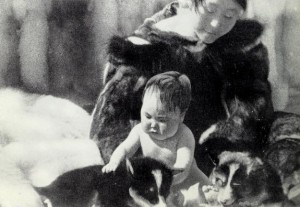
"The filming of "Nanook" was almost an accident. It was not until his third exploration trip into the North in 1913 that Mr. Flaherty packed in his kit the necessary apparatus for making a motion picture of the life of the Eskimo. For a year and a half he lived among them as an engineer and explorer and his admiration for their life, their games, and their struggles, grew on him slowly. He was immersed in enthusiasm. He knew they made fine film stuff. Then, after months of hard work, his precious film was drowned while crossing a rotten ice stream within twelve miles of the journey's end. Undaunted, he made new plans immediately for retaking the picture. His next trip to the North, made especially to take the film, was completely successful. He did away with episodic filming; he built his first camera entity," Amateur Movie Makers, May 1927, 7.
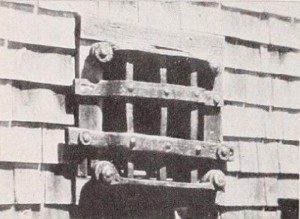
"In filming Nantucket, A Chapter from Early America, Russell T. Pansie chose a happy subject for Kodachrome — the weatherbeaten grays and pastel colors of the ancient buildings of Nantucket. Most color films are made with an effort to present colors as brilliantly as possible, but this picture is a delightful exception, and it is a notable example of the versatility of color film in the hands of a competent cameraman. In Nantucket, A Chapter from Early America, we see the orderly streets of the island, the historic buildings that date from the early Eighteenth Century, the mansions built by the prosperous sea captains of the Nineteenth Century and we glimpse the island's natural charm. But, in the brief footage that he wisely allowed himself, the cameraman has achieved more than an architectural study; he has reproduced the atmosphere of life as it was lived in the past." Movie Makers, Dec. 1943, 474.
Total Pages: 79